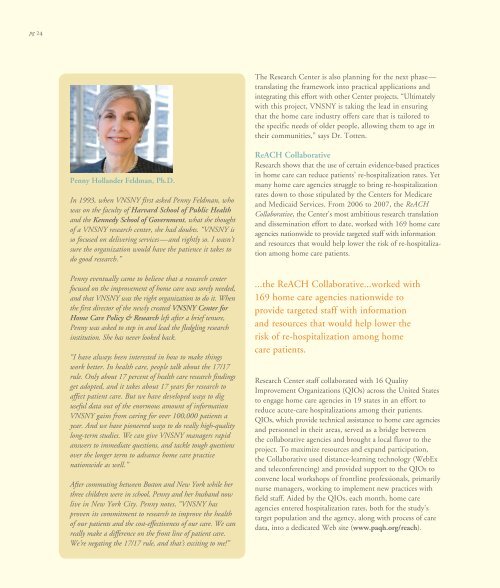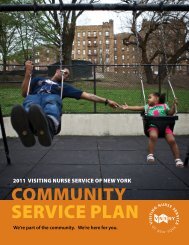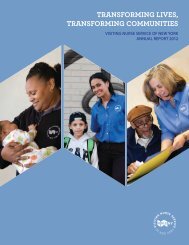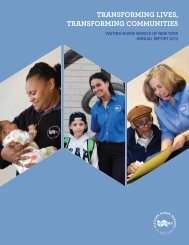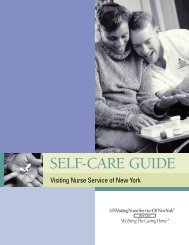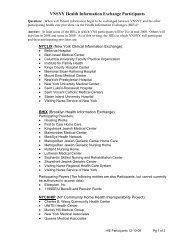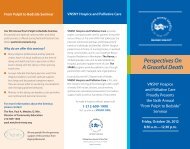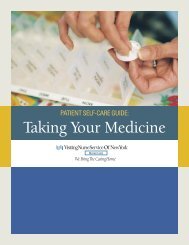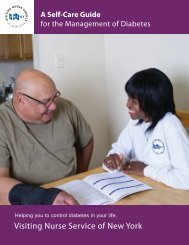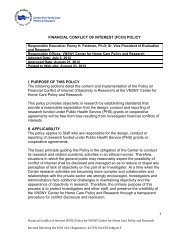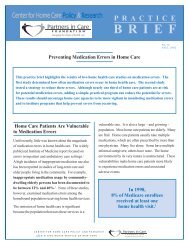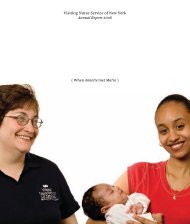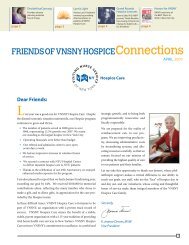2007 Annual Report: We're Here. - Visiting Nurse Service of New York
2007 Annual Report: We're Here. - Visiting Nurse Service of New York
2007 Annual Report: We're Here. - Visiting Nurse Service of New York
Create successful ePaper yourself
Turn your PDF publications into a flip-book with our unique Google optimized e-Paper software.
pg 24pg 25Penny Hollander Feldman, Ph.D.In 1993, when VNSNY first asked Penny Feldman, whowas on the faculty <strong>of</strong> Harvard School <strong>of</strong> Public Healthand the Kennedy School <strong>of</strong> Government, what she thought<strong>of</strong> a VNSNY research center, she had doubts. “VNSNY isso focused on delivering services—and rightly so. I wasn’tsure the organization would have the patience it takes todo good research.”Penny eventually came to believe that a research centerfocused on the improvement <strong>of</strong> home care was sorely needed,and that VNSNY was the right organization to do it. Whenthe first director <strong>of</strong> the newly created VNSNY Center forHome Care Policy & Research left after a brief tenure,Penny was asked to step in and lead the fledgling researchinstitution. She has never looked back.“I have always been interested in how to make thingswork better. In health care, people talk about the 17/17rule. Only about 17 percent <strong>of</strong> health care research findingsget adopted, and it takes about 17 years for research toaffect patient care. But we have developed ways to diguseful data out <strong>of</strong> the enormous amount <strong>of</strong> informationVNSNY gains from caring for over 100,000 patients ayear. And we have pioneered ways to do really high-qualitylong-term studies. We can give VNSNY managers rapidanswers to immediate questions, and tackle tough questionsover the longer term to advance home care practicenationwide as well.”After commuting between Boston and <strong>New</strong> <strong>York</strong> while herthree children were in school, Penny and her husband nowlive in <strong>New</strong> <strong>York</strong> City. Penny notes, “VNSNY hasproven its commitment to research to improve the health<strong>of</strong> our patients and the cost-effectiveness <strong>of</strong> our care. We canreally make a difference on the front line <strong>of</strong> patient care.We’re negating the 17/17 rule, and that’s exciting to me!”The Research Center is also planning for the next phase—translating the framework into practical applications andintegrating this effort with other Center projects. “Ultimatelywith this project, VNSNY is taking the lead in ensuringthat the home care industry <strong>of</strong>fers care that is tailored tothe specific needs <strong>of</strong> older people, allowing them to age intheir communities,” says Dr. Totten.ReACH CollaborativeResearch shows that the use <strong>of</strong> certain evidence-based practicesin home care can reduce patients’ re-hospitalization rates. Yetmany home care agencies struggle to bring re-hospitalizationrates down to those stipulated by the Centers for Medicareand Medicaid <strong>Service</strong>s. From 2006 to <strong>2007</strong>, the ReACHCollaborative, the Center’s most ambitious research translationand dissemination effort to date, worked with 169 home careagencies nationwide to provide targeted staff with informationand resources that would help lower the risk <strong>of</strong> re-hospitalizationamong home care patients....the ReACH Collaborative...worked with169 home care agencies nationwide toprovide targeted staff with informationand resources that would help lower therisk <strong>of</strong> re-hospitalization among homecare patients.Research Center staff collaborated with 16 QualityImprovement Organizations (QIOs) across the United Statesto engage home care agencies in 19 states in an effort toreduce acute-care hospitalizations among their patients.QIOs, which provide technical assistance to home care agenciesand personnel in their areas, served as a bridge betweenthe collaborative agencies and brought a local flavor to theproject. To maximize resources and expand participation,the Collaborative used distance-learning technology (WebExand teleconferencing) and provided support to the QIOs toconvene local workshops <strong>of</strong> frontline pr<strong>of</strong>essionals, primarilynurse managers, working to implement new practices withfield staff. Aided by the QIOs, each month, home careagencies entered hospitalization rates, both for the study’starget population and the agency, along with process <strong>of</strong> caredata, into a dedicated Web site (www.paqh.org/reach).Participating agencies used the site to compare their agencydata with national norms. VNSNY was the coordinatingcenter as well as a participating agency in the collaborative.As the Collaborative was rolled out, sets <strong>of</strong> agencies focusedon selected quality improvement areas and developed actionplans for high-risk populations, which included implementingpractices such as frontloading home care visits or assessingpatients for their risk <strong>of</strong> being hospitalized. Each agencyselected a target group <strong>of</strong> patients and a team to work withthese patients.In Wave I <strong>of</strong> the collaborative, agencies posted a 4 percentreduction in hospitalization rates among target patients. InWave II, there was a 7 percent reduction among targetedpatients. In addition, there was a significant increase—morethan 40 percent—in the number <strong>of</strong> patients who receivedcompleted risk assessments.“The big lesson <strong>of</strong> ReACH is that a national practiceimprovement collaborative is effective,” says MargaretMcDonald, M.S.W., project manager, “even when you’reworking with home care nurses, who are a decentralized,difficult-to-reach group.”Home-Based Blood Pressure Interventionsfor African AmericansApproximately 8 percent <strong>of</strong> home care patients are admittedwith essential hypertension (HTN) as a first, second, or thirddiagnosis, yet management <strong>of</strong> high blood pressure has not<strong>of</strong>ten been subject to guidelines or quality-improvementactivities in home health care. Many patients with high bloodpressure have diabetes, heart disease, or other conditions forwhich HTN represents a major risk <strong>of</strong> complications andpoor health outcomes. African Americans receiving homecare are a particularly high-risk population.Nursing personnel in home care are uniquely positioned to usetheir care management and patient education skills to increasethe proportion <strong>of</strong> HTN patients achieving adequate bloodpressurecontrol. Therefore, the Research Center in 2004launched Home-Based Blood Pressure Interventions for AfricanAmericans—an NIH-funded, randomized trial managed byJennifer Mongoven, M.P.H.—to examine the effectivenessand cost-effectiveness <strong>of</strong> two organizational interventionsaimed at improving blood-pressure control among AfricanAmericans in home care. The two interventions include:(1) a “basic” intervention that delivers key “just-in-time”information to nurses, physicians, and patients while thepatient receives traditional post-acute home health care; and(2) an “augmented” intervention that transitions patientsto a home-based HTN support program, extending theinformation, monitoring, and feedback available to patientsand primary care physicians for an 18-month period beyonda home-care admission. These interventions are being assessedrelative to usual care and to each other. The analysis willestimate the impact <strong>of</strong> each intervention on nursing practicesand processes <strong>of</strong> care, on patient hypertension management(for example, medication adherence), blood pressure outcomes,and costs. As <strong>of</strong> April 2008, 328 nurses and 867 patientsthroughout <strong>New</strong> <strong>York</strong> City’s boroughs are participating inthe study.“What has been helpful to the patients in this program,is that focusing on one condition helps them feel moreconfident in their ability to manage it,” said Paula Wilson,B.S.N., M.P.H. “From there, it is easier for the patient to seehow their co-morbidities are interrelated and that ultimatelyby managing one condition, it may help improve another.”


